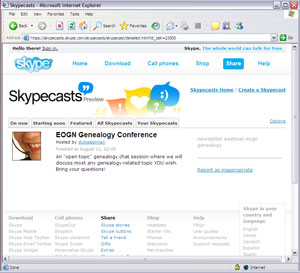The technology worked very well. Dick was an excellent moderator. Everyone tried to be helpful and pleasant. There were some rough edges though. But hey, that's to be expected any time you have a lot of people trying something for the first time.
It was impossible to control the quality of equipment people used. Some people's voices came across clearer and louder than others. But with a little effort and a good amount of coaching and problem solving on Mr. Eastman's part the differences were minimized and the conversations were understandable.
Another issue which was a bit challenging to deal with was people's lack of understanding of how the technology works (and it's limitations). Background noises were a real distraction. The greater the number of people who "had the mike" the more difficult it was to hear good voice quality. As people's use of this technology with multiple callers becomes more commonplace they will naturally learn better etiquette. For example, you can't control/eliminate the sound of a jet flying overhead, but you can cover your mike so that everyone else doesn't have to hear the jet flying over your house. It is much more important to control for all those little (or sometimes not so little) background sounds when you have multiple callers on the line. If one person has a jet flying overhead, another has a dog barking in the room, another is holding their mike a little too closely so that you hear their breathing... well you get the picture. It quickly becomes a cacophony.
The good news is that the technology allows for the moderator to mute everyone's microphone and then turn individual mikes on and off independently. This worked exceptionally well. It seems to me that this type of forum will work best when used that way... not allowing everyone the floor at once seems to be the key. The best scenario would probably be one where the speaker/moderator talks for a while on a given subject and then takes questions one at a time from the other participants. It seems more feasible to use it say in place of a genealogy meeting or seminar on a given topic rather than an open air Q & A session which would be more manageable in a regular (typing) chat room.
It will be interesting to see what Mr. Eastman will do with it next. Overall, I was impressed at what could be done on online, real-time, with this technology. The Skype software was really easy to install and simple to operate. And the best part is, it's free! I think the time has come for virtual genealogy meetings and I think this just may the ticket to get us there. But the technology needs to be sponsored and promoted throughout the genealogy community by the likes of Dick Eastman... people with "power voice" (those with large audiences on web sites, blogs, & newsletters) will need to get the word out so that it can begin to feel more mainstream and less intimidating.
Technorati Tags:
